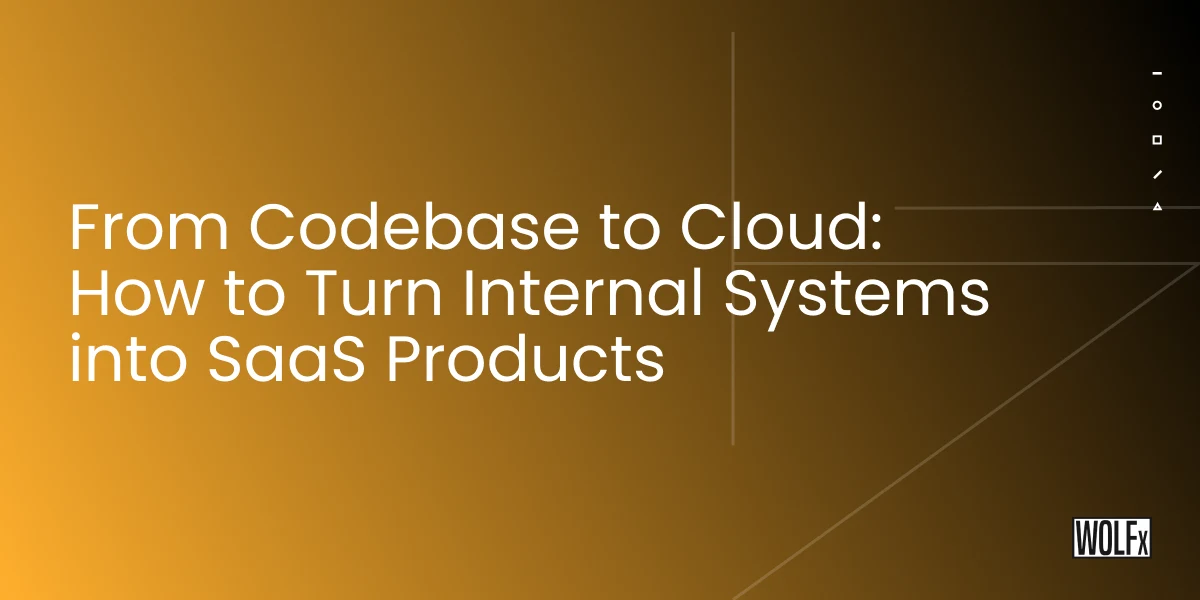With the cloud, businesses can reach farther, engage more customers, and innovate in ways they never thought possible. In today's rapidly changing world, businesses are getting more out of the technology they already use. Internal tools and systems that were previously reserved for internal use are now being rebuilt as SaaS products, enabling entirely new possibilities.
how to transform your in-house systems into saleable, scalable SaaS products. From handling problems to finding solutions, this resource will assist you in the process of transformation with real insights.
Pain Points of Transferring Internal Systems into SaaS Products
1. Non-Scalability
The initial issue that most encounter is scalability. Internal systems are normally created to support a small team or a small set of users. However, as companies expand, the systems may not be able to keep pace with the growing demand. Legacy systems, specifically, weren't designed for heavy traffic or big customer bases and, therefore, tend to deteriorate in performance when you attempt to scale.
2. Security Issues
When you're transitioning from an in-house system to an SaaS product, security is a high priority. Your in-house tools may rely on basic security controls, but your SaaS product is going to have to protect more types of user data. That requires implementing robust encryption, multi-factor authentication, and compliance standards like GDPR or HIPAA.
3. Lack of User Experience Focus
Another obstacle is user experience (UX). Internal systems tend to be constructed with functionality in mind but not necessarily with user-friendly design. A SaaS product, in contrast, needs to be intuitive and simple to use by a wider range of people, which requires reimagining the user interface (UI) and ensuring it's functional and accessible.
4. Integration Issues
Most internal systems are constructed on older infrastructure that may not be fully compatible with newer cloud technologies. As you transition towards SaaS, having your system integrate well with third-party services and cloud-based tools is essential to offering a seamless experience to your users.
5. Cost Implications
Converting an in-house system into a SaaS product is not cheap. It takes a large amount of investment into cloud infrastructure, continuous updates, and maintenance. Converting to the cloud, embracing micro services, and scaling with serverless architecture all need up-front investments, which can be overwhelming, particularly for small companies.
6. Compliance and Legal Challenges
Legal compliance is essential when developing a SaaS product. Your internal system might not have been developed with compliance in mind, so it's crucial to ensure that your SaaS product is compliant with industry-specific regulations, whether it is GDPR, HIPAA, or any other norm.
Solutions to Overcome the Pain Points
1. Designing for Scalability
To address scalability problems, adopt micro services architecture. It enables you to scale individual components of your system independently, making it possible for the product to be able to process high traffic without slowing down. Cloud services such as AWS or Azure can automatically scale resources either up or down depending on demand to provide a seamless experience to users regardless of scale.
2. High-Level Security and Data Privacy
You can't cut corners when it comes to security. Implement encryption, multi-factor authentication, and regular security audits to secure user data. Moreover, make your product compliant with standards such as GDPR or HIPAA, whichever is relevant to your space. Not only will this secure your users, but it will also establish your customers' trust.
3. UX/UI first
User experience is the key to SaaS success. Begin by carrying out user testing and keeping the customer's needs at the forefront. Good UX/UI simplifies your product and retains customers. By prioritizing simplicity, functionality, and accessibility, you can develop a product that is both fun to use and useful.
4. Modernizing Infrastructure
If your internal system is based on legacy infrastructure, it's time to transition to the cloud. Contemporary cloud-native infrastructure is more versatile, and combining APIs and SaaS solutions will make your system more responsive to customer demands. Cloud deployment strategies will also make it easier to maintain and scale your system, all while keeping expenses in check.
5. Cost Management Strategies
Cloud services such as serverless architecture are an excellent means of saving money. With serverless, you spend only what you use without having to provision idle resources. Moreover, using a tiered SaaS pricing model enables customers to pay for what they require while providing you with a sustainable revenue stream.
6. Compliance and Legal Preparedness
Compliance and legal can never come after the fact. Collaborate with legal specialists to design your SaaS product to adhere to all relevant regulations in the first place. Whether GDPR, HIPAA, or another standard, ensure that your product is compliant with all applicable laws so that no expensive mistakes are made in the future.
The SaaS Product Roadmap Transformation
1. Transition Planning
Begin with a definite plan. What functionalities does your internal system provide, and how can these be brought to a SaaS product? Identify your target customers and match your internal system strengths with customer requirements. Divide the process into steps and establish milestones in such a way that your transition is seamless and streamlined, with less interference to your everyday activities.
2. Iterative Development & Testing
This is not a process that occurs overnight. Start with an MVP to collect feedback from actual users. This enables you to catch potential problems early and adjust accordingly. Through continuous iteration and testing, you can make sure that the product gets better over time and is ready to be released to a larger audience.
Frequent SaaS Product Development Mistakes to Avoid
1. Disregarding Customer Feedback
One of the biggest mistakes businesses make is not listening to their customers. Engaging with potential users throughout the development process helps ensure the product meets their needs. Regular surveys, beta testing, and gathering feedback will provide invaluable insights and keep your product on the right track.
2. Underestimating the Importance of Support Systems
Customer support is crucial. A great SaaS product is nothing without solid support to back it up. Make sure you’ve got a strong support team in place and that you’re ready to handle any issues your customers may face. A good support system keeps users satisfied and helps them feel confident in your product.
3. Skipping the Legal Checkpoints
Compliance cannot be ignored. Not complying with legal requirements, such as GDPR or HIPAA, can lead to a fine or legal issues. Engage compliance experts early on so that your product complies with all the regulations required.
4. Complicating the Pricing Model
Simple is better when it comes to pricing. A convoluted pricing model will confuse and repel users. Instead, offer a simple, tiered system so that users may pick and choose features without getting bogged down. This way, you are offering value without complexity.
Conclusion
The process of taking internal systems and turning them into SaaS products is difficult but rewarding. Although it demands a thorough knowledge of scalability, security, user experience, and legal conformance, the payoff is high. By facing all these challenges squarely through meticulous planning, embracing cloud-based solutions, and guaranteeing compliance, companies can open up new avenues for growth and gain more customers. The process can be intricate, but by adopting the right strategy, organizations can develop innovative, scalable products that yield long-term success and establish leadership in their respective industries.

